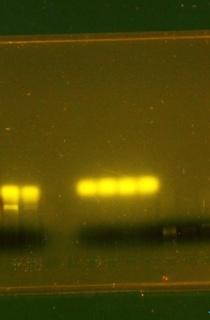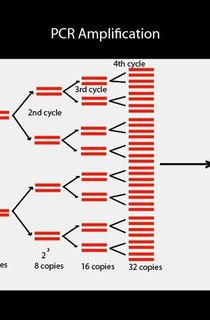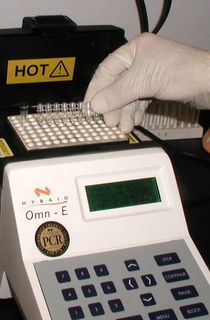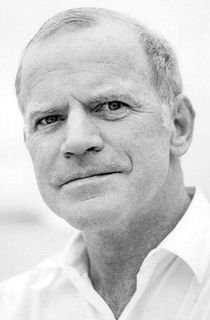The People's PCR
Paul Vanouse’s residency project for ISEA2012 at Neo Rio Questa titled The People’s PCR helps to democratize high-end genetic engineering tools.
Introduction
The Polymerase Chain Reaction is an elegant algorithmic process that allowed Kary Mullis to copy a small region of DNA billions of times, thereby “amplifying” a region, potentially to differentiate individuals. The first great patent of the biotechnological revolution profited Cetus and Roche corporations with the first billion dollar invention. For his discovery, Mullis, along with Michael Smith, was awarded the Nobel Prize in Chemistry in 1993.
Within a few years, the entire process could be performed by a PCR thermocycler, which partially black-boxed the technology.
Algorithm became machine.
Kary Mullis epitomizes (albeit somewhat darkly) the scientific pioneer.
- He is a generalist, able to use and connect concepts outside his specific area of expertise.
- He is a loner who is said to have alienated others at the Cetus corporation where he worked. Varied accounts have Mullis threatening other workers: sometimes carrying a gun, even punching a co-worker at an office party.
- And lastly, he is credited with a big idea that was before its time that he doggedly pursued despite his other duties at the corporation.
PCR is also a technology of “self-discovery”, or less optimistically, authoritarian identification. PCR has replaced the original DNA Fingerprinting methods in many cases, including massive government DNA databases, such as the US FBI’s CODIS project..
I wanted to open up meanings of the PCR discovery/patent during the low-tech PCR experiment, a technologically anachronistic reenactment. In 1989, Science Magazine dubbed Taq Polymerase the “molecule of the decade”. It was discovered in geysers at Yellowstone National Forest in the 1970s... and eventually commercialized for great monetary gain (but not for the national park).
Prior to PCR, scientists seeking to visually analyze DNA fragments needed to radioactively label target sequences and typically they sought better imaging apparatus or stronger radiation to enhance their dim images. Mullis, on the other hand, realizes that DNA regions could be amplified exponentially by successively initiating the DNA transcription process and thus greatly enhance any imaging or analytical process. In his autobiography, Mullis credits frequent LSD experimentation as central to his own personal and scientific development. He also describes a subsequent, enigmatic, deep-woods abduction by a flourescent, extra-terestrial raccoon who greets him with "Good evening, doctor".
Just as context is a meaningful paratext in any cultural activity (such as an artistic performance) the context in which PCR is “invented” by Mullis is fundamental to its cultural meaning, economic value, and scientific merit.
When Mullis begins his exploration, there is a big problem. It has no purpose. The idea of duplicating a region of DNA exponentially is “cool”, but of little use in research or industry. However, by the time he obtains publishable results, the technology is of great utility for Genetic Engineering (allowing one to duplicate a gene for transplant) and DNA Typing (allowing one to compare highly variable regions of DNA). Changing context turns a neat trick into an indispensible laboratory tool.
Mullis’ “invention” occurs at the brink of the biotech era, while patent laws were being stretched as the private biotech corporation ascended over the university research laboratory. “Invention”, is used in quotes here as every part of the process had already been invented—the patents were highly contested by scientists who had developed these individual components of the PCR process. PCR is only an invention in the changing context of research science, which made Mullis’s “idea” unique.
--Paul Vanouse
Value and Impact
Paul Vanouse’s residency project for ISEA2012 at Neo Rio Questa titled The People’s PCR helps to democratize high-end genetic engineering tools. According to Vanouse’s essay about the launch of a similar project in Banff, Deep Woods PCR (excerpted in the description), the PCR (Polymerase Chain Reaction) “is an elegant algorithmic process that allowed Kary Mullis to copy a small region of DNA billions of times, thereby ‘amplifying’ a region, potentially to differentiate individuals. The first great patent of the biotechnological revolution profited Cetus and Roche corporations with the first billion-dollar invention. For his discovery, Mullis, along with Michael Smith, was awarded the Nobel Prize in Chemistry in 1993.”
Vanouse has devised a way to perform one of the key processes in PCR over a campfire with simple equipment. Thermus Acquaticus is an organism that can survive high temperatures and therefore remain living through the PCR process. The genes of this high temperature tolerant organism can be combined with other organisms therefore allowing the PCR process to be used with a variety of living DNA. This makes Thermus Acquaticus a very valuable species to those that profit from the biotech industry.
Paul collaborated with visual artist and Buffalo professor Joan Linder, who created an exquisitely drawn book of the process including trip to three hot springs to find Thermus Acquaticus. The two residencies were part of the Neo Rio festival created by Clare Cote and Jon Wenger. The Wild Rivers park where the festival is held is part of BLM land, this residency was one of the first BLM hosted residencies.
Bibliography
Dancing Naked in the Mind Field, Kary Mullis, Vintage Press, 1998.
Making PCR: A Story of Biotechnology, Paul Rabinow, University of Chicago Press, 1996.
"Biotech in Court: A Legal Lesson on the Unity of Science" Kara Swanson, Social Studies of Science, 2007; 37; 357.
Further Reading
http://socialmedia.hpc.unm.edu/?p=1602
http://www.paulvanouse.com/dwpcr.html
http://www.youtube.com/watch?v=qDM0wxuGiEo
http://leapsite.org/neorio/neorio-2012-powers-of-sun-wind-and-water/
http://www.taosnews.com/calendar/event_d9bc5f0c-03fd-11e2-bac5-4718cad258e2.html
http://blogs.kent.ac.uk/sciencecomma/2012/08/05/fellow-experimenters-in-art-and-science-part-ii/
No comments yet. Why not add the first?
Showcase
Prepared By Andrea Polli on behalf of ISEA2012 Albuquerque: Machine Wilderness
Areas Covered
Acknowledgements & Credits
Contributors:
Paul Vanouse, Artist
Joan Linder, Artist and Illustrator




← Back to work
0 Comments